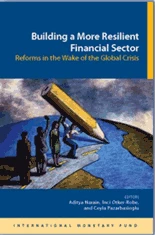
The International Monetary Fund (IMF), alongside the Bank for International Settlements and Financial Stability Board, has been at the forefront of discussions on shaping the new financial system to reduce the possibility of future crises and limit the consequences if they occur. Current reforms are moving in the right direction towards building a more resilient financial system capable of supporting sustainable economic growth, but many policy choices—both urgent and challenging—still lie ahead. Progress has been made in some areas, including in reforming capital (including for systemically important financial institutions—SIFIs), recognizing the importance of a wider regulatory perimeter to oversee shadow banks, improving supervision, disclosure, and resolution regimes, and addressing incentives for risk-taking. Policymakers put forward some novel ideas, such as living wills and contingent capital (CoCos). But they lagged in implementation in many areas, while disagreeing over others.
The task is surely not easy. The ongoing crisis led to an unprecedented dislocation in financial markets. It damaged stability and confidence in many advanced financial systems, with major consequences for growth and employment. Policymakers face many setbacks as they ride through uncharted territories created by cracks in the financial architecture. The tough policies needed to reform the system have been further complicated by negative feedback loops that have set in between sovereign and banking risks as growth prospects deteriorate. The threat of disorderly deleveraging further undermines successful implementation of the reforms.
At the same time, financial stability risks continue to rise as economic and financial uncertainties surrounding the euro area linger. As José Viñals, the Financial Counsellor of the IMF, noted recently, “lasting stability is not yet ensured.” Complementing the key policy steps he highlights to ensure durable stability is to finalize the financial reforms proposed to address the market failures that planted the seeds of the crisis. This is necessary not only to limit the regulatory uncertainty weighing on the financial system and the real economy, but also to provide a yardstick for emerging markets that need to limit a buildup of financial imbalances.
Lessons for Policymakers
A number of key takeaways emerge from the book:
- Banks will attempt to mitigate the impact of tighter regulations on their profits. The impact will likely be greater for banks with significant investment-banking activities, which also have the most flexible business models. A key challenge is to ensure that tighter bank regulations achieve material reductions in systemic risk, while avoiding an unintended shift of risky activities to less-regulated sectors and locations.
- Expanding the perimeter of regulation and oversight and regulatory coordination across borders and sectors are essential to limiting such consequences. While this will increase the regulatory burden, the cost of the alternative is also high. But despite its growing importance, the shadow banking system remains poorly understood and largely unregulated. Global regulators now see shadow banking work as a top priority, and aim to produce regulatory reforms to address the risks it poses.
- However, good regulation, even when extended, would be insufficient without good supervision that is intensive, skeptical, adaptive, comprehensive, conclusive, and proactive in a world of ever-adapting industry, complex instruments, and interconnected systems. Willingness and ability to take timely action requires appropriate resources, skills, mandate, independence, and accountability. But translating the agreed principles into national practices takes time, and banks will likely be always steps ahead.
- Enhanced transparency would complement these efforts. Regulators and supervisors cannot do their job effectively without access to adequate data and information. Neither could creditors and shareholders assess risks and impose market discipline without it. Ongoing global efforts to fill information gaps, especially for global SIFIs, must accelerate.
- It would be a mistake to think that all failures can be eliminated, even with effective and smart regulation, supervision, and data. Well-designed resolution frameworks that help deal smoothly with failing institutions are essential (at national and global levels) to minimize the disruption failures cause. Orderly resolution must be a credible option for market discipline to work. But the absence of effective resolution regimes for cross-border banks is the greatest challenge in this process.
- Lack of progress in establishing effective resolution frameworks lies at the core of the TITF problem associated with SIFIs. Their scale, complexity, and interconnectedness make SIFIs difficult to manage, supervise, and resolve, and they have the potential to spread distress to the broader economy. Implicit government-backing gives them competitive advantage, reinforcing moral hazard and concerns about a level-playing field. Despite all the work, the global community is still unequipped to allow SIFIs to fail. Until this is achieved, SIFIs must be subject to more stringent prudential rules and supervision consistent with their systemicness, enhanced disclosure, and compensation policies designed to limit excessive risk-taking.
- Much can be gained from requiring financial firms to prepare living wills. Global SIFIs are now required to show how they would unwind in the case of their demise, providing information on their structure, commitments, and exposures. Such plans facilitate supervision and resolution efforts, helping prepare for contingencies. However, they are challenging to implement, especially for cross-border firms, putting close cooperation again at the heart of the matter. Methods and criteria are needed to assess firms’ resolvability on a consistent basis.
- Contingent capital instruments, or CoCos, could also be a potential tool for resolution and prevention. CoCos can be automatically converted into equity or written down upon a pre-determined trigger event, enabling fresh injections of capital to absorb losses. If designed properly, they could be part of a comprehensive crisis management framework and improve market discipline through burden-sharing with creditors. Still untested, CoCos need to be scrutinized to avoid adverse effects on market dynamics.
- Why not break up SIFIs then, to end the TITF problem? This could, in principle, prevent institutions from becoming systemic and contain the cost of their failure. Limits on scope could separate their core activities from riskier ones, arguably making the system less interconnected. Size and scope measures could be difficult to implement on a globally consistent basis, however. Potential gains from diversification could be lost, with large adjustment costs and implementation challenges. If moved to the shadows, restricted activities could leave risks in the system, if they create nonbank SIFIs linked to banks.
- If SIFIs cannot be broken up or their activities constrained, could they be structured as subsidiaries rather than branches? Some host-countries made calls to isolate foreign banks’ local operations from problems in parents or affiliates and to have greater control over them. But when subsidiarized on a standalone basis, banks need to hold sufficient capital and liquidity to survive on their own, with tight limits on intragroup operations.
- There is no one size fits all answer when it comes to organizational structure. Subsidiarization can shield businesses from losses in the group, make it easier to spin-off and restructure individually, and facilitate living wills through simpler group structures. But imposing self-sufficiency can undermine ability to manage risks for wholesale banking groups and leave affiliates alone under stress, if local markets are shallow. Policymakers should strive toward the first-best, with harmonized resolution regimes accompanied by adequate buffers and risk management capacity.
Challenges Ahead
Work is clearly progressing on many of the building blocks of a resilient financial system. But implementation has been painfully slow, challenged by an uncertain environment, and we continue to run the risk of missing the symptoms of another crisis. The book reminds us that policy-makers have no choice but to complete the unfinished agenda. And financial institutions have no choice but to swallow the bitter medicine that is appropriate for the risks they take, while supervisors continue to watch attentively, both what is in the light and the shadow. Countries must pay extra attention to the implications of their actions on others, striving for consistency, and keeping incentives in check. None of this is easy. But neither is the global economy able to afford repetition of a crisis of this intensity.


Join the Conversation